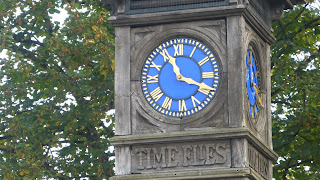
As with the previous station at Lancaster Gate, this station does not have escalators so it's either walking up 123 steps or take the lift. You would think that as it has a lift it is disabled friendly but no you still have a dozen steps before you access the lift.

The station is on the corner of Queensway and Bayswater Road. The outside looks in need of a good coat of paint.


Looking up Queensway I noticed that a couple of hundred metres away is Bayswater Tube station.
I always try not to overlap areas around the stations so I only walked a short distance down Queensway hoping to see Queensway ice rink, the largest in London, but unfortunately it is closed for renovation. I will have to put that on my list of places to revisit.



This house was built in 1823/4 and was designed by John Laudon, a landscape architect. Looking like a detached villa it is two houses disguised as one. Using the dome and dummy windows he created the illusion of two houses to look like one detached villa. The idea of illusion was favoured by some English architects of that time.


Another architectural illusion can be seen here at 23 and 24 Leinster Gardens. When the subterranean lines of the Underground (Metropolitan Railway as it was then) were first constructed in 1863, a method known as 'cut and cover' was used. Basically, dig a hole for the train and cover with a tunnel. One of the lines required the demolition of 23 and 24 Leinster Gardens which were part of a terrace of five storey houses. It was decided to build a 5ft thick facade which matched the houses. If you look closely you can see the dummy windows and lack of a letter box in the doors.
The gap behind the facade can clearly be seen from Porchester Terrace. The gap also provides a welcome open air space for dispelling fumes and smoke ( as the original trains were steam driven).
Following the line back to Queensbury Terrace you can still see a gap behind this property
More delightful Mews cottages
 On Craven Hill Gardens is this block of flats, built in 1964, which seems to be totally out of place .
On Craven Hill Gardens is this block of flats, built in 1964, which seems to be totally out of place .
I returned to Bayswater Road to see the weekly art exhibition along the park railings. Every Sunday numerous artists display their work here.
Next to the playground is the Elfin Oak, now enclosed in a wire cage to prevent damage. The Elfin Oak sculpture was made from the trunk of an ancient oak tree (900 years old) which originated in Richmond Park. Sculpted by Ivor Innes in 1930 it has numerous elves, fairies and animals living in its branches and bark. Some readers might recognise it from inside the cover of Pink Floyd's 1969 album 'Ummagumma'


To the right of the pond is Kensington Palace.
 Kensington Palace is the Royal residence of the Duke and Duchess of Cambridge (William and Kate) as well as Prince Harry and some minor Royals. Diana, Princess of Wales, had an apartment here from 1981 until 1987.
Kensington Palace is the Royal residence of the Duke and Duchess of Cambridge (William and Kate) as well as Prince Harry and some minor Royals. Diana, Princess of Wales, had an apartment here from 1981 until 1987.
The Palace was built in the 17th C for King William and Queen Mary. The Palace was needed quickly as the King wanted to move away from Whitehall to the cleaner air of Kensington. To speed up the building of the Palace it was built in brick not stone and was completed in six months.
King William and Queen Mary moved in in 1689. Sadly, Mary died of smallpox in 1694 and in 1702 William died after falling off his horse.
 There is a large bronze statue of King William III at the side of the Palace.
There is a large bronze statue of King William III at the side of the Palace.Designed by Princess Louise in 1893, this marble statue is of her mother, Queen Victoria. It shows the Queen in her coronation robes at the age of 18. Victoria was born in Kensington Palace and lived there until she became Queen in 1837.

There are formal gardens at the front of the Palace that you can see from a number of viewing points.

The Orangery is also in the garden and is now a restaurant open to the public.
Another viewing point looking back towards the Round Pond.
I left the park past these ornamental gates.
I exited via Kensington Palace Gardens. This road has its fair share of opulent billionaire's mansions and Embassies. It was laid out on the site of the kitchen gardens of the Palace between 1844 and 1870. This view shows the Palace railings.

This view looks back along this wide tree lined road.
Half way down is this Victorian pillar box and gas lamp

At the end of the road you can see the lodge gates, a common feature during the 18th C and 19th C. There are gates at either end of the road for security reasons.
There is also an armed police presence as this road has so many embassies and access to Kensington Palace. Once through the gates I was back on Bayswater Road just a short distance from Queensway station.





















































